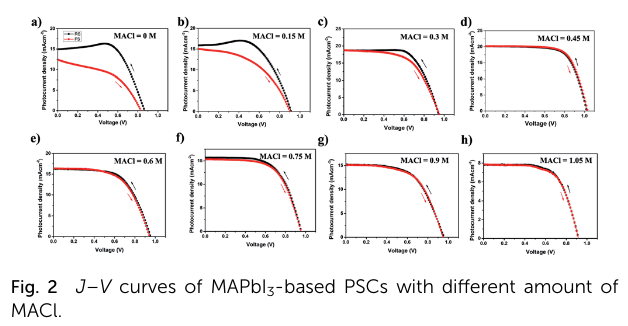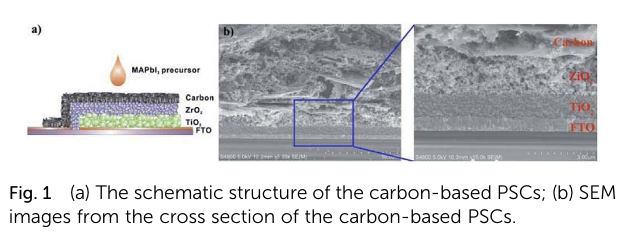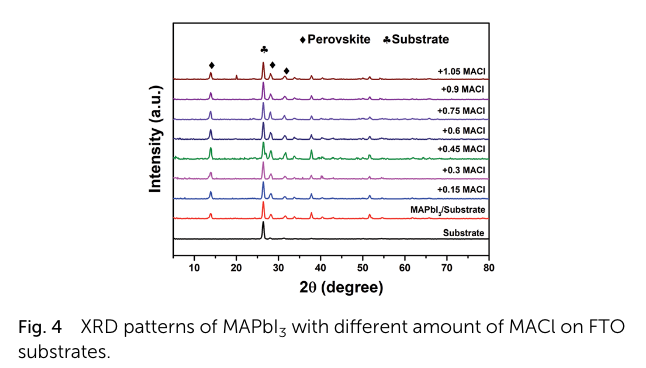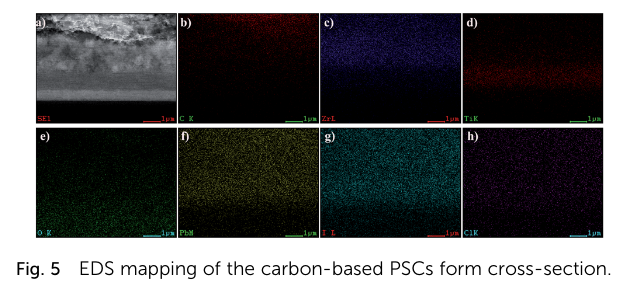Alleviate the J – V hysteresis of carbon-based perovskite solar cells via introducing additional methylammonium chloride into MAPbI ₃ precursor
(2018) - Huirong Jiang, Xingyu Liu, Nianyao Chai, Fuzhi Huang, Yong Peng, Jie Zhong, Qi Zhang, Zhiliang Ku, Yi-bing Cheng
- Link:
- DOI: 10.1039/C8RA04347G
- Zotero Link: Alleviate the J – V hysteresis of carbon-based perovskite solar cells via introducing additional methylammonium chloride into MAPbI ₃ precursor
- Tags: #paper
- Cite Key: [@jiangAlleviateHysteresisCarbonbased2018]
- Linked notes: Paper Annotations
Abstract
The hysteretic phenomenon commonly exists in the J – V curves of perovskite solar cells with different structures, especially for carbon-based mesoscopic perovskite solar cells without hole-conductor (carbon-based PSCs). , The hysteretic phenomenon commonly exists in the J – V curves of perovskite solar cells with different structures, especially for carbon-based mesoscopic perovskite solar cells without hole-conductor (carbon-based PSCs). By adding moderate amounts of methylammonium chloride (MACl) into MAPbI 3 perovskite precursor, we found the J – V hysteresis of carbon-based PSCs could be significantly alleviated and the crystallinity of MAPbI 3 perovskite could also be influenced. With the increasing amount of MACl, MAPbI 3 perovskite showed better and better crystallinity until the MACl came to 0.45 M. The champion device with 0.45 M of additional MACl exhibited a preferable PCE of 14.27% for reverse-scan (RS) and 14.50% for forward-scan (FS), significantly higher than that of the pristine device (8.74% for RS and 4.80% for FS). What's more, the J – V hysteretic index of the device gradually decreased along with the increasing amount of MACl, and kept at low value even when the crystallinity of MAPbI 3 perovskite became poor. Through XRD and PL analysis, we demonstrated that the recombination rate of the accumulated charges at the perovskite/TiO 2 interface is the main reason for photocurrent hysteresis in carbon-based PSCs. High quality of perovskite crystals is an important contributing factor for high-performance PSCs with low hysteresis, but there is no necessary correlation between low hysteresis and good crystallinity. This research presents an effective way to fabricate carbon-based PSCs with low-hysteresis, and at the same time, provides evidence for investigating the origin of J – V hysteresis of PSCs.
Notes
Annotations (1/20/2023, 9:53:00 AM)



13.91 peak strongest at 0.45 M of MACl

"From the cross-section of the sample (Fig. 5a), we can clearly nd the elements of carbon (Fig. 5b), zirconium (Zr, Fig. 5c) and titanium (Ti, Fig. 5d) distribute homogeneously in the top, middle and bottom area, respectively. Oxygen (Fig. 5b) is mainly exists in the ZrO2, TiO2 and FTO substrate. For perovskite, elements of lead (Pb) together with iodine (I) and chlorine (Cl) have a uniform distribution in carbon/ZrO2/TiO2 layers."

They dropcast on 2 different substrates: glass/ZrO2, and FTO/TiO2
Good PL in glass/ZrO2 for 0.45 MACl indicates fewer traps and defects in perovskite
Large quenching (lower PL) in FTO/TiO2 for 0.45 MACl indicates better electron extraction across the interface.
“By adding moderate amounts of methylammonium chloride (MACl) into MAPbI3 perovskite precursor, we found the J–V hysteresis of carbon-based PSCs could be significantly alleviated and the crystallinity of MAPbI3 perovskite could also be influenced.” (Jiang et al., 2018, p. 1)
“champion device with 0.45 M of additional MACl exhibited a preferable PCE of 14.27% for reverse-scan (RS) and 14.50% for forward-scan (FS), significantly higher than that of the pristine device (8.74% for RS and 4.80% for FS).” (Jiang et al., 2018, p. 1) #nodes_research
J-V characteristic of carbon based PSC done in forward and reverse bias to see the hysteresis
“Through XRD and PL analysis, we demonstrated that the recombination rate of the accumulated charges at the perovskite/TiO2 interface is the main reason for photocurrent hysteresis in carbon-based PSCs.” (Jiang et al., 2018, p. 1)
“no necessary correlation between low hysteresis and good crystallinity.” (Jiang et al., 2018, p. 1) #nodes_research no correlation between low hysteresys and good crystallinity
“Since rstly be reported in 2013, carbon-based PSCs have been studied by many research groups in aspect of mate- rials, interface engineering, solvent engineering and long-term stability.8–15 However, like other types of PSCs, carbon-based PSCs suffer from the current density–voltage (J–V) hysteresis as well. The J–V hysteresis inuences the PCE of a solar cell device and occurs as a result of the large discrepancy between the forward and reverse scans. Though researchers haven't come to an agreement on the origin of this anomalous hyster- etic behaviour in PSCs, most of them considered that ion migration,16,17 ferroelectricity,18,19 a photo-induced capacitive effect20,21 and charge trapping/detrapping22,23 could be the reasons. F” (Jiang et al., 2018, p. 1) #nodes_research First carbon based perovskite solar cell was reported in 2013. The reason behind hysteresis in PSC are here
“By adding extra methylammonium chloride (MACl) into MAPbI3 perovskite precursor, we found that the J–V hyster- esis of the device disappeared gradually as the increasing amount of MACl. For dug reason, the X-ray diffraction (XRD) and steady- state photoluminescence (PL) measurements were performed on the devices. The XRD results showed that the crystallinity of MAPbI3 perovskite can be improved by certain amount of MACl, and better crystallinity also brings higher PCE to the device.” (Jiang et al., 2018, p. 2) #nodes_research Why use MACl
“Furthermore, with continuous increasing the amount of MACl, the crystallinity of MAPbI3 perovskite got worse and worse.” (Jiang et al., 2018, p. 2) #nodes_research adding more MACl will decrease the crystallinity. The optimum mol is 0.45 M
“However, the J–V hysteresis of the devices still kept at low level.” (Jiang et al., 2018, p. 2)
“the recombination rate of the accumulated charges at the perovskite/TiO2 interface is the main reason for photocurrent hysteresis.” (Jiang et al., 2018, p. 2) #nodes_research using PL measurement, the hysteresis come from the recombination of accumulated charges at perovskite/TiO2
“The pristine perovskite precursor was prepared by dissolving the mixture composed of 461.01 mg PbI2 and 158.97 mg MAI in 1 mL DMF to achieve 1 M MAPbI3 precursor solution.
The MACl-incorporated perovskite precursor was prepared via adding x mmol MACl (x ¼ 0.15, 0.3, 0.45, 0.6, 0.75, 0.9, 1.05) into 1 mL pristine perovskite precursor to achieve MAPbI3 with x M MACl precursor solution.” (Jiang et al., 2018, p. 2)
“The cross-sectional structure and elemental distribution of the perovskite solar cells were investigated with eld-emission scanning electron microscopy (FE-SEM, Zeiss Ultra Plus) equipped with an EDS detector.” (Jiang et al., 2018, p. 2) #nodes_research people use FE-SEM and EDX to see cross-sectional and elemental distribution
“Steady-state photo- luminescence spectra were measured by a PL microscopic spectrometer (Flex One, Zolix, China) with an excitation wave- length of 532 nm” (Jiang et al., 2018, p. 2)
“As shown in Fig. 4, all of the perovskite samples exhibit similar diffraction peaks at 2q values of 13.91, 28.20 and 31.69, corresponding to the (110), (220) and (310) crystal planes of tetragonal MAPbI3 perovskite. With the adding of additional MACl from 0.15 M to 0.45 M, the peak at 2q value of 13.91 gradually increased its intensity, indicating better and better” (Jiang et al., 2018, p. 3) #nodes_research
XRD peaks of MAPbI3 perovskite
“crystallinity of MAPbI3 perovskite” (Jiang et al., 2018, p. 3)
“When we continue increased the amount of MACl (from 0.6 M to 1.05 M), the crystallinity of MAPbI3 became worse again.” (Jiang et al., 2018, p. 3)
“Moreover, no obvious MAPbCl3 peaks can be found in these patterns, indicating most of the chloride was released in the annealing procedure or the chloride only exist in the boundaries of MAPbI3 crystals.” (Jiang et al., 2018, p. 3)
“To conrm this, energy disper- sive X-ray spectroscopy (EDS) measurement was performed on the device with champion PCE.” (Jiang et al., 2018, p. 3)
“However, the atom ratio of Pb, I and Cl is around 1 : 2.56 : 0.12, indicating only a few Cl exist in MAPbI3 perovskite. Thus, we deduced that most of the Cl elements were removed in the form of MACl gas24 by annealing” (Jiang et al., 2018, p. 3) #nodes_research
Cl not seen significantly,may be removed in the form of MACl gass during annea
“further study the different J–V hysteresis behaviour of MACl- incorporated MAPbI3 perovskite, steady-state photo- luminescence (PL) spectra measurements were carried out on the glass/ZrO2/perovskite and FTO/TiO2/perovskite samples.” (Jiang et al., 2018, p. 3)
“The MAPbI3 with 0.45 M MACl lm on the glass/ZrO2 substrate showed the strongest PL intensity, indicating fewer traps and defects within the perovskite crystal (Fig. 6a).” (Jiang et al., 2018, p. 3)
“perovskite samples with FTO/TiO2 substrate (Fig. 6b). All of the MAPbI3 perovskite lm with MACl exceeding 0.3 M possessed a dramatically higher degree of PL quenching in comparison with other samples with lower amount of MACl. Generally, this PL quenching is attributed to originate from efficient electron extraction across the interface.25 Hence, we can conclude that the charge carrier extraction at the perovskite/TiO2 interface could be enhanced by introducing sufficient MACl into MAPbI3.” (Jiang et al., 2018, p. 4)
“And J–V hysteresis in carbon-based PSCs is mainly depends on the charge carrier extraction speed rather than the crystallinity of perovskite.” (Jiang et al., 2018, p. 4)
“Note that, for the carbon-based PSCs, there is no signicant relationship between the interfa- cial charge extraction and the crystal quality of perovskite.” (Jiang et al., 2018, p. 4)
carbon based perovskite tuning MACl in MAPbI3